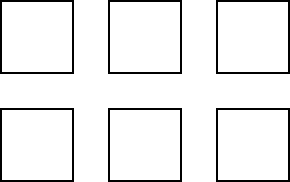Copyright © University of Cambridge. All rights reserved.
'Coloured Squares' printed from https://nrich.maths.org/
Show menu
Why do this problem?
This problem gives children the chance to become more familiar with everyday words which describe position. It also requires them to work in a systematic way.
Possible approach
Before trying this task, you might like to arrange some coloured sheets of paper on the floor, or to have some coloured circles arranged on the interactive whiteboard. Ask the children to talk about what they can see (perhaps in pairs first), drawing attention to the use of appropriate vocabulary, for example above, below, next to, opposite, in between, to the left of, to the right of
etc.
For the problem itself, you might like to provide pairs of children with coloured counters or squares of coloured paper or multilink cubes so that they are able to physically recreate the arrangement. You could start with some simpler one-step instructions and only three or four counters to get the children into the task, then some two-step instructions which are independent of each other.
Present the problem orally, repeating it several times, and leave them time to have a go. Depending on their reading level, you could also supply a few copies of the clues around the room so that they can refer back. If not using counters, you could give children copies of this sheet for them to colour,
or of course they could work in pairs at a computer using the interactivity.
In a plenary, bring out the steps that had to be taken in order to solve the problem, for example, you can invite children to say how they started. This is a good opportunity to raise their awareness of different approaches and learners can use the interactivity on a whiteboard to demonstrate their own method.
Key questions
Where could the blue counter go? (Or which square could be blue?) How do you know?
How does the second clue help?
Try colouring the squares, or use counters to try out an idea. Does your arrangement fit the clues?
Possible extension
Pupils could make up their own version of this problem for a friend to solve (or for the whole class to try in the plenary).
Possible support
Encourage children to work together in pairs to solve the problem. You could pair a strong reader with one who is less confident in reading so that they are still able to check the clues, or an adult could repeat them as necessary.
